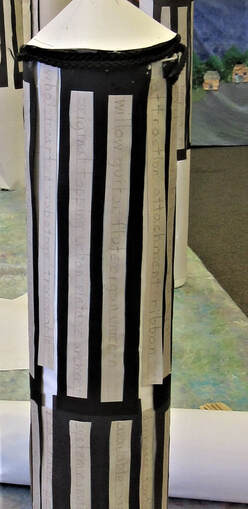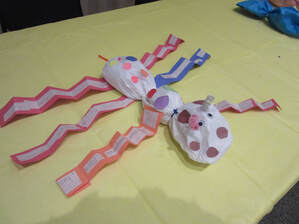 A Saturn V rocket made from pop bottles and construction paper, covered with words that students have captured, is an intrinsic motivator. The project is fun and the students learn new words.
A Saturn V rocket made from pop bottles and construction paper, covered with words that students have captured, is an intrinsic motivator. The project is fun and the students learn new words. I smiled and then began to explain. The craft projects that I use at my reading clinic are actually teaching tools. I use the craft projects to help children overcome the anxiety of failure and the disappointment of not being able to learn to read. Learning to read is very hard for some children. They find it frustrating. Reading then becomes something that they dread and feel very negative about; this leads them to not want to read. In contrast, craft projects provide an intrinsically motivational environment that encourages students to read. Intrinsic motivation is an internal desire within the student. Craft projects are intrinsically gratifying and children in my programs read to make hands-on craft projects.
We must create a learning environment that encourages all students to want to learn. This is true whether we are teaching 30 children in the classroom or tutoring a single student in a one-on-one tutoring session.
Therefore, craft projects do not waste time. Instead, they make learning easier for the child. They make learning to read take less time than usual. What may look like a mere craft project becomes a hands-on teaching technique that helps struggling students learn to read.
Is using craft projects successful?
We have had children move up 4 grade levels in reading in one year. These were children who were failing in school and who had also failed to learn to read with systematic one-on-one phonics tutoring. So, yes, using hands-on crafts as a teaching tool can teach students to read.
I am a motivational psychologist. I work with children and teens who are struggling in reading or, in many cases failing in reading. My programs help students “erase” that feeling of “I can’t” or “I failed.” At my reading clinic, we’ve helped many failing students return to the classroom and do well. A 15-year-old who failed for nine years in reading learned to read in 3 ½ years. So, the methods that I use are very successful, and they work for all ages.
The first step is to create a learning environment.
Hands-on craft projects help create a learning environment that encourages children to want to learn. Creating an intrinsically motivating learning environment is how we had two students move up 2 grade levels in reading after only 48 hours of instruction.
The hands-on craft project becomes the teaching tool that helps to create an intrinsic learning environment. Intrinsic motivation is more successful in the classroom and for learning than extrinsic motivation. Intrinsic motivation is the key to successful learning.
Let’s stop and define our terms.
How does intrinsic motivation work?
Motivation is the driving force that explains student behavior in the classroom, especially how a student approaches trying to learn something new—like reading. Motivation can be intrinsic (internal) or extrinsic (rewards).
Intrinsic motivation can involve the student’s internal desire to explore a new topic, to try to learn something even though it may be hard, to want to learn, to keep trying and to try again in the face of failure. Intrinsic motivation produces better long-term outcomes and classroom performance, better grades, better test scores, and a stronger desire to learn.
Tutors must use intrinsic motivation as well as teachers. Even though you may only be working with one student, it is critical to focus on intrinsic rather than extrinsic motivation during tutoring sessions.
What is extrinsic motivation?
Extrinsic motivation is an incentive or reward that drives a student to perform a particular behavior—grades, competition, food, money, promise of a prize or reward. Extrinsic rewards can turn negative if the student doesn’t feel that the reward is worth the effort. For example, the student might not work unless you offer two candy bars instead of just one. Also, extrinsic motivation does not give long-term positive effects. Extrinsically motivated students lack an internal desire to learn; they must be prodded, threatened, or bribed each time you want a certain action (completing an assignment). Such compliance is not true motivation.
_______________________
For more about intrinsic and extrinsic motivation, read Group-Centered Prevention in Mental Health: Chapter 6, “Is Intrinsic Motivation Better Than Extrinsic Motivation?”
_______________________
Why are we talking about motivation?
You may even be asking, what does motivation have to do with reading? Everything. If a student is not motivated to want to learn to read, the chances are very strong that they will never be able to. Unfortunately, it is not possible to motivate another person. Yes, you can bribe. Yes, you can offer rewards or incentives. Yes, you can threaten or force. But those methods are not true motivation.
This is not just a play on words. Motivation is an essential ingredient for learning. Motivation is a vital part of tutoring and classroom success. In any classroom or one-on-one tutoring setting, motivation becomes the guiding influence that encourages the student to strive to achieve and perform up to their potential. Intrinsic motivation occurs when a student wants to master a task (like learning to read) instead of just completing an assignment to get it finished and out of the way, not really caring about the quality of their work. Research shows that intrinsic motivation leads to better classroom performance and learning than extrinsic rewards.
So, yes, we must build motivation, especially intrinsic motivation into our reading program. Without intrinsic motivation, students will become bored, not pay attention, not be willing to tackle hard learning tasks, and not believe that it is possible to learn to read. When you remember that according to the Nation’s Report Card over 60% of students in the 4th, 8th, and 12th grade cannot read at grade level, then the importance of incorporating intrinsic motivation into your reading program takes on new urgency.
_______________________
For more on the Nation’s Report Card, read Why Does Phonics Education Fail?_______________________
How do you generate intrinsic motivation?
We’ve already seen that you cannot motivate a person or even a student. So, how do we create intrinsic motivation in the classroom or when we are tutoring? We create a motivational environment that will generate intrinsic motivation in the student. At my reading clinic, hands-on projects as puppets, pop-up books, rockets, race cars, alligators, volcanoes, octopuses, squids, frogs, and even a rainforest are intrinsically enjoyable. The hands-on project is always tied to the vowel sound that we are studying. Remember, it is a teaching tool, not just a craft project. Hands-on learning techniques and hands-on projects help to create an intrinsically motivating learning environment.
_______________________
For more on creating a motivational environment, read: Teaching Technique #8: Hands-on Learning
_______________________
 Children read and follow directions to make Ashley the Ant from simple craft supplies.
Children read and follow directions to make Ashley the Ant from simple craft supplies. An Ashley the Ant puppet is a good example. The puppet’s name emphasizes the vowel sound being studied, and Ashley can be either for boys or girls.
Ashley the Ant has six legs and sends the children around the room to “capture” 30 words. Instead of saying that a word is wrong or missed, “capture” that tricky word—just a bit of fun. Captured words are words the student does not know. Not just a fun craft project, Ashley the Ant becomes a teaching tool. Ashley helps the students practice new words.
At the reading clinic, the children travel around to eight different workstations. Six of those stations have new words for the children to read and spell. The words are all listed in progressive steps of difficulty; so, there is something for every ability level.
The children will capture five new words at each workstation to put on the legs of their Ashley puppet. Yes, Ashley the Ant is also a puppet and helps the students work on reading fluency as they participate by reading for a puppet play. Older students may even write stories about Ashley that they read at the end of the work session.
Therefore, with one simple craft project (made from scrap paper and leftover odds and ends), Ashley the Ant introduces students to 30 new words to read and spell. No, we do not memorize a word list. Instead, the students read (breaking words down letter by letter or by cluster—decoding and then reassembling those letter sounds by encoding and pronouncing the word).
With Ashley, there is also a puppet play to read and practice (fluency), step-by-step directions to read and follow (one of the best ways to teach comprehension), and handwriting practice as they place their captured words on Ashley's legs. The puppets go home so that the children can read and practice their new words with their parents.
What if the child doesn’t finish the puppet?
The session never becomes about just finishing the puppet. In my programs, we never just stop and finish a craft project so that children may take their project home. If the craft project is not finished at the end of a session, the student’s name goes on the project, and it goes on the “to be finished” table. Why? Because the hands-on craft project teaches decoding, encoding, spelling, handwriting, comprehension, and reading fluency. When the students return, they finish their project, not just by finishing the craft project, but by returning to the teaching task and completing the decoding, encoding, spelling or comprehension task from the original workstation assignment. As I tell the children, “You cannot drive a car down the road on only two wheels; you must finish building the car before you can drive it.”
A simple craft project can be a teaching tool that heals the hurt and pain of failure
So, as you can see, Ashley the Ant is definitely more than just a craft project. Ashley becomes a means for creating intrinsic motivation. Excitement fills the room as children learn new words and practice reading. The children are eager as they finish their puppets and get ready for the puppet play.
Ashley the Ant becomes a technique for healing the psychological damage caused by failure. A simple paper puppet teaches students to try again. They succeed because we use vowel clustering teaching methods which give students the skills needed to be successful. Positive words are good, but not enough. The student must be taught the skills necessary to succeed.
For a preview from my new book and an example of how I use this same concept in my tutoring programs, see the preview below.
-------------------------------------------------------------------------------------------------------------------------------------------

from pages 109-110.
How to Make a Hands-On Teaching Aid
The first thing to remember about using a hands-on teaching aid is that you do not want to make the hands-on project in its entirety at the beginning of the session. The idea is to make the puppet as you teach. This gives a reluctant child a chance to get excited about making a puppet while they are learning.
The Sir Iggy puppet is an excellent example. You can build a puppet as you teach the letter sounds throughout the four levels. The puppet also corresponds to the stories because the stories are about Sir Iggy. Then, you can use the Sir Iggy puppet to reteach any sections that the student is having trouble with. Here’s an example.
A Sir Iggy puppet was a perfect teaching tool for my student who was having trouble with letter i vowel sounds. Sir Iggy’s name includes two of the vowel sounds for the letter i: short i and the ir sound. Sir Iggy makes kites. He is also a tiny giant; so there were lots of opportunities to practice letter i words when making a Sir Iggy puppet.
I increased my students’ interest in Sir Iggy by making the puppet a medieval knight from the 1300’s. The idea of kites had been brought back to Europe by Marco Polo around 1282; therefore, Sir Iggy could have been a kite maker in the 1300’s. My student loved history and became very excited about making a medieval costume for the puppet. We did a little research.
A medieval costume for men would’ve been a belted tunic with a mantle and possibly a hood over the head. We used two 2-litre pop bottles to make the puppet (You may also use plastic water bottles.). Since the story says that Sir Iggy is a tiny giant, my student wanted her puppet to be tall but not too tall.
Since my main goal in making the puppet was to encourage my students to work on difficult vowel sounds, we glued the two 2-litre pop bottles together end to end. That left a bottlecap on each end. We set the bottles aside to dry and worked on letter sounds.
Later, we came back and added a head for Sir Iggy by rolling a sock down and shaping it to fit on one of the bottle caps. We glued the sock in place, and while it was drying, we worked on more letter sounds.
Next, we returned to the puppet and added a tunic. I had cloth scraps available, but you may also use paper. In medieval times, men’s tunics would be floor-length; so, we covered the puppet from head to toe in the cloth selected. We glued it in place and set it aside to dry while we went to work on more letter sounds.
Then, we came back to make a mantle (shaped like a long cape) with a hood. Again, my student selected cloth from the creative box, but paper would also work. The mantle was laid aside until we added the words.
Yes, all this time, the student had been capturing words and writing them on manuscript writing paper using colored pencils. She decorated the tunic by gluing short i vowel sound words along the lower edge. She glued long i vowel sound words along the lower edge of the mantle. She added a face to Sir Iggy by gluing on sequins and other tiny decorations for eyes, a nose, and a mouth. She used yarn for hair. Words along the border of the mantle and tunic help to stiffen the cloth and create a structure for Sir Iggy‘s costume.
The last part of Sir Iggy’s costume was to make a kite. In medieval times, kites were not diamond-shaped or triangles as we often see today. Kites were boxy. Kites often depicted animals, birds, or flowers. My student decided on a pink boxy kite. She added ir and schwa sound words to the kite.
The bottom bottlecap became the puppet handle, and my student was ready to go and teach others about letter i vowel sounds. We made up a puppet play and had Sir Iggy teach about letter i vowel sounds.
You can use any kind of puppet. The idea is to make the puppet one step at a time so that you are constantly going back-and-forth working on the puppet and then going and working on letter sounds and words. This back-and-forth process encourages students who are reluctant to work on difficult tricky vowel sounds. Quite simply, they want to finish the puppet. To finish a puppet, you need to capture words. Don’t let a puppet become just a simple arts and craft project. Instead, use the puppet as a teaching tool. The student must learn the words to finish the puppet.
Learning really can be fun. You can even add a bit of history to your puppet making as I did with Sir Iggy.
----------------------------------------------------------------------------------------------------------------------------------------
If you’d like to see a longer preview from the book, click here.
If you have questions or need help in tutoring, please contact me. I’m always happy to help.
 RSS Feed
RSS Feed
